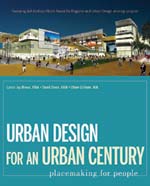
|

|
|
Home Site Search Contact Us Subscribe
|
|
|
Book Review: "Urban Design for an Urban Century: Placemaking for People," by Lance Jay Brown, David Dixon, and Oliver Gillham To the credit of the erudite authors, their sketch of urban design brings levels of political, sociological, and architectural analysis together in a readable synthesis. By Norman Weinstein September 17, 2009 Urban Design is an extraordinarily complex subject to write about. I’m looking at my opening sentence, wondering if such a truism need be stated in order to fairly assess the value of this worthy and infuriating book. I’ll stick with that assertion because Urban Design for an Urban Century: Placemaking for People (John Wiley & Sons, 2009) offers a very thoughtful and worthwhile and simplified overview of the (overwhelmingly Euro-American) history of the key paradigms, principles, and process of urban design. It breezes by a reader in the first 100 pages. Think of a 21st-century animated film equivalent (in “Blade Runner” tempo, hyper-cyber-presto) of Lewis Mumford’s The City in History: Its Origins, Its Transformations, and Its Prospects. If you want an overwhelmingly complex history of urban design, don’t look here.
On the plus side, I can’t think of a more critically valuable (albeit simplified) overview of city forms in this compressed treatment. To the credit of the erudite authors, their sketch of urban design brings levels of political, sociological, and architectural analysis together in a readable synthesis. Their apparent biases – pro-New Urbanism, anti-iconic Postmodernism – never interfere with their acute awareness of key themes (like how to build cohesive sustainable communities by recognizing the need for multi-disciplinary experts to listen carefully to stakeholders). The first 100 pages could make a terrific introductory reading for an urban design course.
But one caveat needs to be mentioned. “Placemaking for People,” the book’s catchy subtitle, is defined as an optimal fit of people and place. “Optimal” is defined by the authors as energy-efficient public transportation, serviceable and responsive to the economic and social needs of an increasingly diverse society. All commendable objectives. But remarkably little concrete information is given in the book’s supersonic overview of urban design explaining in-depth why so many U.S. urban design programs have failed in the past century. This is definitely an upbeat reading experience – bless the authors for that – but I would have enjoyed a far more comprehensive overview of the history of urban design that would have given food for thought about how and why the best laid plans for people/place fell by the wayside. What were the various interpretations of lessons learned from urban designs gone wrong so that the same design errors aren’t repeated in the future?
The book’s second half consists of 70 case studies of projects that have won the American Institute of Architects’ Honor Awards for Urban Design. The authors frame the studies effectively with their concise summaries of what key urban design principles and paradigms came into play with each project, a useful counterpoint to the sometimes pretentious and often vague AIA Jury comments.
Bottom line: read the book’s first half as a stimulating discussion of the history of city design. Pick and choose the case studies in the text’s second half that seem useful. For now, the best text on urban design may come into being from your walking the long way home.
Norman Weinstein writes about architecture and design for Architectural Record and The Christian Science Monitor. He consults with architects and engineers interested in communicating more profitably. You can reach him at nweinste@mindspring.com.
Also by this author:
Op-Ed: Life After Ada: Reassessing the Utility of
Architectural Criticism
Best Architecture Books of 2008
Book Review: You've Got to Draw the Line Somewhere A review of Drafting Culture: a Social History of Architectural Graphic Standards by George Barnett Johnston
Book Review: "NeoHooDoo: Art for a Forgotten Faith," edited by Franklin Sirmans Sharpen your pencils - and get ready to do a NeoHooDoo shimmy
Book Review: A Subversive Book Every Architect Needs:
"Architect's Essentials of Negotiation" by Ava J. Abramowitz
Book Review: A Perspective from One Elevation: "Conversations With Frank Gehry" by Barbara Isenberg Gehry's conversations offer portraits of an astute listener as well as talker, an architect as aware of his flaws and limitations as of his virtues.
WORDS THAT BUILD:
Introduce Words that "Float" into the Flow of Communications with
Clients
WORDS THAT BUILD:
Work with Clients to Develop Plans That Place Human/Spatial Relationships First
WORDS THAT BUILD: Faster! Deeper! Broader!
WORDS THAT BUILD: Translate Images Into Touching
Performances
WORDS THAT BUILD: Emphasize Words with Lasting Resonance
WORDS
THAT BUILD: Re-invent Green Communication
WORDS
THAT BUILD: Taking Advantage of Interruptions in Architectural Communication
WORDS
THAT BUILD: Faceting Architectural Communication
WORDS
THAT BUILD: Use Space Creatively When Designing Your Client Communications
WORDS THAT BUILD: Making Your Client's Contradictions
Productive
WORDS THAT BUILD: Initiate Conversations with Designs
that Engage Your Clients
WORDS THAT BUILD: Creating a Site Analysis That's Out of
Sight
WORDS
THAT BUILD: Learning How to Persuade Through Learning Variations on a Theme
WORDS
THAT BUILD: Respecting Key Words as Materials for Building Durable Structures
WORDS
THAT BUILD: Steering Your Client in the Appropriate Direction
WORDS
THAT BUILD: Playing with the Flow of Communication
WORDS
THAT BUILD: Clarifying Presentations to Clients through Rhythmic Emphasis
WORDS
THAT BUILD: Coping with chaotic communication challenges
|
(click on pictures to enlarge) 
|
© 2009 ArchNewsNow.com